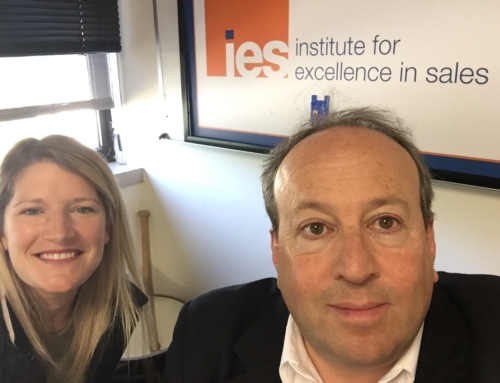IES Executive Director Fred Diamond was interviewed by Eric Quanstrom, CMO at KiteDesk, as part of the KiteDesk Expert Interview Series. You can see the interview on the KiteDesk site here.
The Institute For Excellence in Sales (IES) was created to grow excellence throughout the Sales operational process, to help sales teams optimize their efforts. To start, what did IES feel was missing, in the sales industry that prompted the foundation of your organization?
Back only 10-15 years ago, it was not uncommon for sales people to receive up to two weeks of sales training yearly. In fact, when I started at Apple Computer, I received up to 4 weeks of sales training including presentation skills, prospecting, account development, and customer relations skills training each year. The number of days companies offered their salespeople for training has decreased significantly over the years, although the amount spent on sales performance improvement as a whole is close to $10 billion each year!
We saw two trends that seemed to provide an opportunity for the IES. First, there were a lot of young professionals entering the profession without much context to help them be successful. Companies were only training their new employees on what they needed to perform their jobs and were missing on offering a wider range of skills. Many new sales professionals were telling us that they did not know how to perform much outside of pounding the phones or toying with social media selling. We wanted to help them understand what it meant to be a sales professional and teach them skills they would need to be successful.
Also, on the other end of the spectrum, we saw senior sales reps who were getting lost in the social media selling frenzy. One very successful sales leader I knew grabbed me by the arm one day and said, “Help me. Do I need to know how to tweet?”
“Help me. Do I need to know how to tweet?”
This was a guy who had 30-plus years of sales success. He was lost in how the world had been changing.
Those two reasons (and others) are what prompted me to start the IES.
What IS excellence in sales? How can you recognize it when you see it?
That’s a great question. We believe that the highest level of success in selling can be achieved by understanding, practicing, and executing the science of selling. Many people shy away from professional sales because they think of sleazy used car sales people. In fact, the best companies in the world have succeeded because they have a world-class sales enablement and performance process in place.
Top sales professionals know that they must bring value to their customers or they will not succeed. They need to help their customers grow their business and find ways to help them achieve their goals. They then need to understand how to effectively communicate that they understand how to do this. There are many facets to successful sales.
The IES was created to serve those in complex, typically business to business (B2B) sales be more effective.
IES serves as a center for actionable best practices, insights, tools, advice, and thought leadership for sales professionals. What are some best practices for generating sales leads? And what makes insights actionable, and what difference does that make?
The biggest trend over the past decade has been that customers could have access to everything they need on the Internet. While in the past, the customer would expect to get educated by the sales rep, they now have access to other buyers, information, pricing data, and service information to help them get deep into the buyer process. In some cases, estimates are that the customer can be 60 percent into their buying decision process before they even contact a rep.
The best reps know this and are constantly seeking ways to bring more value to their customer or they will get shut out. Good reps today spend more time researching the needs of their customer, learning about issues their customer’s industry may be facing, and solutions they might not know about.
Along those lines, what are some ways to position a business as a thought leader in their industry? How can this actually be a useful source of lead generation?
Customers are more challenged than ever to succeed. Competition in most industries is fierce and everyone is looking for an edge. One way that sales professionals can provide more value is by bringing their customers solutions to the challenges they face in business.
From the customer perspective, being recognized as a thought leader can be an edge for them. If not a thought leader, they can bring tips and solutions to THEIR customers to help THEM be more effective. One blog article will not do the trick, however. There needs to be sustainment and continual effort and production.
Video is becoming a surprisingly useful tool for sales teams and marketers, with a much higher click-through rate than email marketing. What are some ways that video content can be useful for generating useful sales prospects? Are there any pitfalls emerging video producers should avoid?
That’s true, video is becoming huge. Here is one word of warning for the young sales professionals out there. One video will not close the deal for you. When I was a junior marketer at Apple, I was proud of a new print data sheet we produced for one of our new markets. I previewed it to the top Apple rep in the market expecting a nice slap on the back. His comment, which I never forget, was “a brochure alone will never sell a product.”
The point is that nice, crisp videos offering a solution or clear understanding of something the customer might not know can help, but you have to remember that need to fit into the overall sales and marketing effort.
Social media can be a goldmine for unearthing new leads and clients. What are some signs someone should look out for, to identify potential sales leads in their industry on social media?
One of our sponsors, Vorsight, has created the 3 x 3 approach before calling on a prospect. Use three minutes to find three speaking points before calling a prospect. In business-to-business selling, LinkedIn is the right place to start. Scour it for blogs and articles the prospect might have written, speeches they might have given, and panels they might have been on.
You do not need to be a librarian, per se, and spend an hour doing the research. With discipline, three minutes can be enough to find some great information you can share. The conversation can go something like, “Hello Ms. Johnson. This is Bob Smith from MyCompany. I read your recent blog on how new technologies can be helpful in identifying identity breeches. Have you thought about this technology?…”
For B2B sales professionals, understanding how to mine LinkedIn should be step one.
IES hosted a symposium recently, the 2017 Customer Acquisition Symposium, in Tyson’s Corner, Virginia. What were a few things you went over in that symposium? How were they received?
This was the second symposium we held. One of the missions of the IES is to bring sales thought leaders and sales leaders together. We had over 150 sales leaders register for the program. The two main topics, as suggested by IES members, were how to prospect better and how to build a stronger sales mindset. Each of our six world-class speakers addressed those topics with great results.
On the prospecting front, two of our speakers, best-selling authors Tom Snyder and Mark Hunter gave attendees new ideas and strategies on how to prospect higher in the organization and enrichen their pipelines.
On the topic of mindset, John Asher and Marissa Levin offered ideas on how sales professionals could refine their development activities to become stronger sales reps.
It was a great day and our attendees learned a great deal that they could implement immediately.
What are some of your predictions, regarding customer acquisitions in 2017? Which techniques are going to be the most important, do you think?
There are three things sales professionals need to be conscious of to be successful in 2017 and beyond.
First, the Internet is not going away so the customer will continue to be able to access as much information as they need to learn and get facts before they even call the sales rep to come in. As good sales reps know, the later you are called into a deal, the less likely you’re going to be successful.
Thus, more than ever, sales professionals need to continue to find ways to bring value to their prospects. They need to be preemptive in their communications with solutions that might help their prospects solve their challenges. This simple exercise will help sales professionals take their careers to the next level.
Second, they must want to continually improve their craft by getting better at prospecting, relationship building, presenting, using social media or any other tactical element that is in front of them. We believe at the IES that professional selling success is based on science and their more sales professionals treat their business as such, the more success they will find.
Finally, they’ll need to take more chances by building a richer, deeper mindset of success. So much has been written about how having a stronger mindset is critical in any area of success. In sales, it is even more so.
One thing that’s universally true, in all kinds of sales, is the need for transparency, trustworthiness, and honesty. How might a company or sales team show themselves to be trustworthy, without bragging or being pushy?
Another way that the world has changed for sales professionals is that customers can hide out easier. It’s nearly impossible to get into buildings anymore with a security pass. The old concept of “walking the halls” does not work anymore because you cannot get into the buildings. Plus, prospects hide behind voicemail, unanswered emails, and going silent. Smart, alert customers have made it very difficult for sales people to be successful by being pushy, dishonest or unethical.
However, customers are more often than not interested in learning more about how they can combat their business challenges. If a sales professional is bringing them value, they should be open to listening. This value should not mean how my product or service can help you, but communicating something the sales rep has noticed that the customer may be blind to.
No one likes to “be sold to” however people will usually value ideas and advice that will help them move their business forward.
Are there any best times of the day or week for finding useful sales leads, that you’ve noticed? How might a sales team leverage that info to better connect with their lead?
Mark “the Sales” Hunter taught us about the 58/2 rule. People are usually done meetings at 58 minutes after the hour and might be more apt to take your call. If they don’t have a meeting, they might be free at 2 minutes after. Try it!
Author: Eric Quanstrom
Eric is Chief Marketing Officer at KiteDesk. He guides global marketing activities, including inbound, web presence, social media, corporate communications, and user experience programs that build on KiteDesk’s objective to be the leading Sales Development software in the world.








